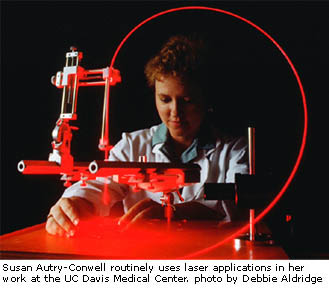|
|
Diverse Campus Team Aces Bid for Biophotonics Center
Mediaworks Plays Integral Role
|
|
|
|
Diverse Campus Team Aces Bid for Biophotonics Center
Mediaworks Plays Integral Role
|
|
|
To many, the use of lasers and light to examine and treat medical patients seems the stuff of science fiction, techno-miracles existing only in Jedi tales and star treks. However, this dream may soon become a reality, as the knowledge and application of biophotonics (the science of using light and other energies to analyze and measure biological tissues) is beginning to expand rapidly with UC Davis at the forefront. In a bid for a new Center for Biophotonics, Science and Technology, Mediaworks recently assisted a cross-disciplinary team of UC Davis researchers in a "flawless" review by the National Science Foundation (NSF). Funded primarily through a grant from the NSF, this new center would facilitate collaboration across disciplines and provide equipment and lab space for scientists as they develop new biophotonics applications and techniques. The UC Davis proposal, headed by Dennis Matthews, Ph.D., an Adjunct Professor in the Department of Applied Sciences, also emphasized reaching out to students (particularly minorities) to enter and train in this new cross-discipline field.  What Will Biophotonics Do?
Biophotonics offers the ability to diagnose and monitor disease nearly at the speed of light, based on the way it interacts with tissue. With biophotonics, healthcare professionals will know in moments what before took hours or days with traditional tests, enabling treatment to begin immediately. Future uses of this technology will severely minimize, and in some cases virtually eliminate, the hospital time and long recovery periods that current procedures require.Biophotonics also allows for studying human tissue at the cellular and molecular level for the purposes of detecting, diagnosing and monitoring disease. At the UC Davis Medical Center, biophotonic technology is being utilized in an experimental device that recently started clinical trials for taking biopsies in women for breast cancer. If this trial is successful, it may eliminate the radical lumpectomy procedure that is now used to take a tissue sample from the breast. Other applications of this technology include the non-invasive early detection of diabetes and cervical cancer. UC Davis Makes the Finals
Recognizing the revolutionary impact of biophotonics, over 150 academic institutions applied for the 40 million dollar grant offered by the NSF. UC Davis was chosen as one of the 11 finalists. To determine whom will receive the grant, a NSF committee conducts a "site review" with each finalist, meeting with researchers and staff, listening to detailed presentations, and reviewing the facilities and infrastructure. The UC Davis team hosted the site review team on October 23rd.According to Dr. Matthews, Mediaworks and UC Davis proved ready for the challenge, as the site review went exceptionally well. "The presentations, organization, food service, transportation, panels, posters, student luncheon, audio visuals, and computer services were accomplished without a single detectable glitch," says Dr. Matthews. Mediaworks Brings It All Together
To make the NSF visit a success, effective collaboration was needed between a wide variety of departments and individuals. The staff at Mediaworks was enlisted to do a variety of things, including creating posters, putting the presentations together and ensuring the technology worked smoothly. "I worked with eleven different presenters and their colleagues and staff. We put together a full-day presentation to showcase the work already done by these high profile individuals. We wanted to demonstrate how all their disciplines, research and discoveries would come together in this new Center to benefit the campus, students and humankind in a shared environment," offers Steve Oerding, an artist in Mediaworks. The final result involved integrating eleven different PowerPoint presentations with video, movies and animations into a single presentation.Other members of the Mediaworks team included Curtis Chiuu, who handled file downloads and provided software and network support and Jeremy Cook, who converted many of the different movie files into a single file format before assembly on a CD. Claudia Graham and Maureen Coulson were instrumental in creating a large amount of poster displays for the project under a tight deadline. "The displays were well received," shares Oerding, "and they added a lot of punch to the information being given in the show by breaking down the specific information into bite size chunks for the site reviewers to digest easily. Pete Peterson from Information Resources also provided backup support throughout the site review. The NSF's funding announcements are expected to take place during March-April 2002, with the funding beginning in August 2002. Regardless of the final decision, Matthews is pleased with the effort of Mediaworks and the UC Davis team: "I feel very content that we did the best possible job of exhibiting our potential to host a Biophotonics Center." Send us your comments on this story. |
|
|